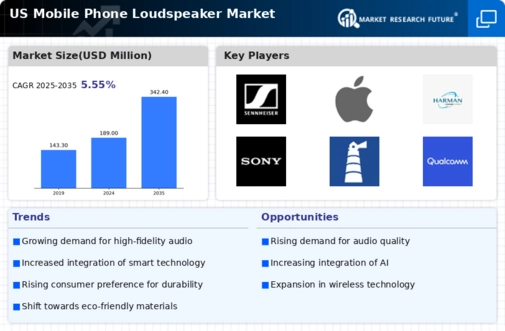Increased Adoption of Streaming Services
The proliferation of streaming services has significantly impacted the mobile phone-loudspeaker market. As more consumers subscribe to platforms such as Spotify, Apple Music, and Netflix, the need for devices that can deliver high-quality audio playback has intensified. Recent statistics suggest that over 70% of smartphone users in the US utilize streaming services regularly, which correlates with a growing preference for mobile devices equipped with advanced loudspeakers. This trend indicates that manufacturers must prioritize sound quality in their product offerings to cater to the audio demands of streaming enthusiasts. The increased adoption of streaming services is likely to drive innovation and competition within the mobile phone-loudspeaker market, as brands seek to enhance their audio capabilities to attract and retain customers.
Rising Demand for Enhanced Audio Experiences
the mobile phone-loudspeaker market is experiencing a surge in demand for enhanced audio experiences. Consumers are increasingly seeking devices that deliver superior sound quality, which is driving manufacturers to innovate and improve their loudspeaker technologies. This trend is reflected in the market data, indicating that the segment for high-fidelity audio products has grown by approximately 15% in the last year alone. As users engage more with multimedia content, including music and video streaming, the expectation for high-quality sound has become paramount. Consequently, companies are investing in research and development to create advanced loudspeakers that can meet these evolving consumer preferences. This rising demand for enhanced audio experiences is likely to propel growth in the mobile phone-loudspeaker market, as brands strive to differentiate themselves through superior sound performance.
Technological Integration with Smart Devices
The integration of mobile phones with smart devices is becoming increasingly prevalent, influencing the mobile phone-loudspeaker market. As consumers adopt smart home technologies, the demand for seamless connectivity between smartphones and smart speakers is rising. This trend suggests that manufacturers are focusing on developing loudspeakers that can easily interface with various smart devices, enhancing the overall user experience. Recent data indicates that around 40% of smartphone users in the US own at least one smart device, highlighting the potential for growth in this segment. The technological integration with smart devices is likely to drive advancements in the mobile phone-loudspeaker market, as brands strive to create products that offer enhanced compatibility and functionality.
Growing Influence of Social Media and Content Creation
The rise of social media platforms and content creation has emerged as a significant driver in the mobile phone-loudspeaker market. With the increasing popularity of platforms like TikTok and Instagram, users are more inclined to create and share audio-visual content. This trend has led to a heightened demand for smartphones that feature high-quality loudspeakers, as users seek to produce engaging content that resonates with their audience. Market analysis indicates that approximately 60% of content creators prioritize audio quality when selecting their devices. As a result, manufacturers are compelled to enhance their loudspeaker technologies to meet the expectations of this growing demographic. The influence of social media and content creation is likely to continue shaping the mobile phone-loudspeaker market, driving innovation and product differentiation.
Consumer Preference for Compact and Lightweight Designs
the mobile phone-loudspeaker market is experiencing a shift in consumer preferences towards compact and lightweight designs. As users increasingly prioritize portability, manufacturers are responding by developing sleeker and more efficient loudspeaker systems that do not compromise on sound quality. This trend is particularly evident among younger demographics, who favor devices that are easy to carry and use on the go. Market Research Future reveal that approximately 55% of consumers consider size and weight as critical factors when purchasing mobile devices. Consequently, brands are likely to focus on engineering loudspeakers that are both powerful and compact, ensuring they meet the demands of a mobile-centric lifestyle. This consumer preference for compact and lightweight designs is expected to drive innovation and competition within the mobile phone-loudspeaker market.




















Leave a Comment